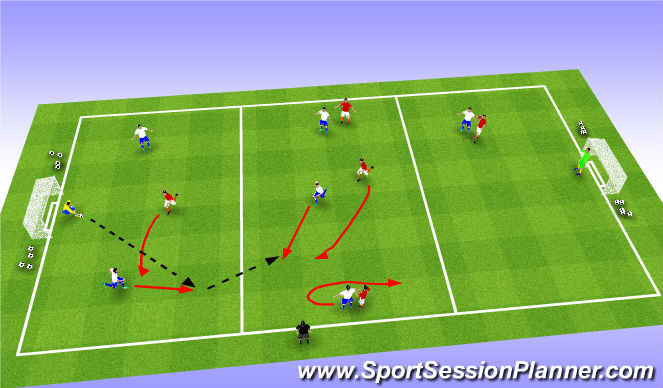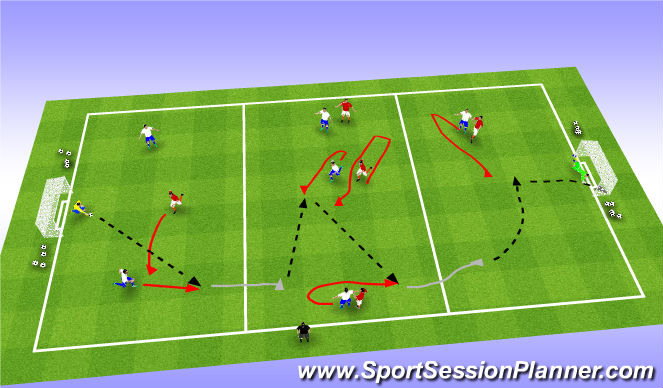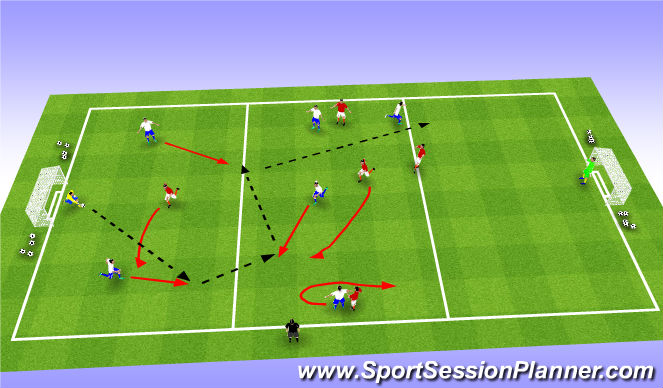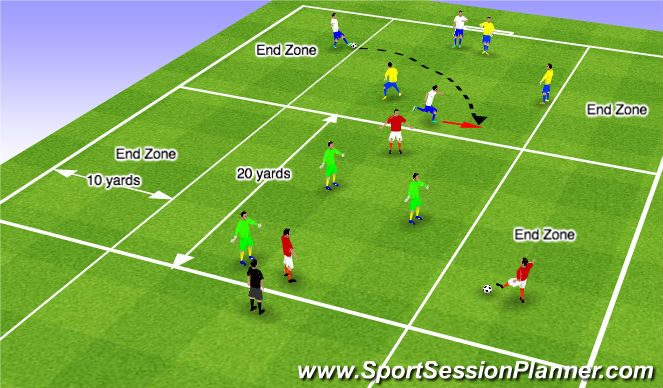Football/Soccer Session (Moderate): In possession: Attacking through the thirds (Start Time: 2018-03-17 10:00:00)
Profile Summary

| Name: | Noel Sritharan |
|---|---|
| City: | Middlesex |
| Country: | United Kingdom |
| Membership: | Adult Member |
| Sport: | Football/Soccer |
Description
In possession - Principles of play: Penetration, Support and movement (Retain and build)
Theme: Technical & Tactical: Playing out from the goalkeeper to players in the defensive thrd who aim to get the ball into the middle third players to ulimately get the ball into the attackng third through ptience and penetrative possession, under opposition.

See the guidance at the top of this page to understand why you are not seeing interactive Football/Soccer images.

Learning Objectives

|
Technical Bein able to play in different scenarios using dribbling, running with the ball (travel) and using different parts of the feet to pass the ball, ball manipulation in 1v1 situaions. |

|
Tactical Patiently building possession to penetrate through the thirds and create overloads in each third. |

|
Physical Movement to support and receive. |

|
Psychological Decision making - when to pass, when to travel with the ball. Confidence to create with the ball and receive under pressure, having a picture of what success looks like. |

|
Social Communicaiton throught verbal and non verbal cues. |
Locked in (20 mins)
Organisation: Team in possession (focus) playing 1-2-4-2 vs 1-3-4-1 (6v6, 7v6 or 6v6 with neutral player in middle and in red teams defensive third if 2 neutral players). Ensure there are plenty of footballs by the goals to ensure repetition. Aim to play the ball through the thirds to score 1 point and score also. To get players can get used to the practise and to avoid "bunching up" players are locked into their thirds as displayed. In the example there is a 2v1, a 3v3 and 1v1 for the team starting in possession in an 7v6 so the team in possession can enjoy success and the opposition can play under the pressure of an underload.
The practise starts with the ball on the goal line and the goalkeeper must kick, opposition can not tackle but can intercept (10-15 minutes). After some successes by the team in possession (white team), allow tackling (full pressure, no sliding tackles) (10-15 minutes), rotate players so both sets of players get an opportunity to try different positions and scenarios in this practise. Adapt numbers to suit ability and number if players on the day, if some players are not involved directly in the practise for a few minutes, the opposition goalkeeper can introduce a different coloured ball and the opposition can attempt to play through the thirds while the other ball is active to create further chaos in the game and engage more players.
Individual focus: Central midfielder (8)
Unit focus: centre backs (5&6) and 8 (primary), 8 with the wide players (2 and 3), 8,2 and 3 with the striker (9).
Primary focus: Looking to penetrate each third to score a point.
Secondary focus: can we maintain possession and build until an opportunity to play forward arises.
Tertiary: Can we create a goalscoring opportunity once the ball is in the final third.
Opposition management: Look to win the ball and get forward quickly.
Coaching position: On the sideline but a particular focus on the central players.
Coaching points:
- Decision making selection of pass type (short/ long), height, part of foot, which foot passing to (receiving player), which player (are they marked? are they outnumbered in their area of the pitch? Can they combine to overload their area of the pitch?).
- Pass execution/ penetration e.g. technique of pass (passed to back foot, front foot if under pressure, chest etc.), pace of pass, curl if needed.
- Supporting players positioning and movement off the ball to support current and future player on the ball (difficult).
- Checking shoulders for opponents, space to exploit, create or maintain and team mates.
- Supporting players move in front of, away or behind defender as necessary, half turn to receive, side on .
- Width and dispersal: create width and disperse to create space in central areas for 8.
Interventions: Allow players to have a go for ten minutes and guide learning by questioning pass selection (when, where and why?), how we can support the player on the ball (use of tactic board) and who are directly working with the 8 (units)? During play regularly praise and re-iterate coaching points with goalkeeper and other parts of the units. If play continually breaking down change format e.g. 7v5 or similar with neutral players to increase success.

See the guidance at the top of this page to understand why you are not seeing interactive Football/Soccer images.

Learning Objectives

|
Technical Bein able to play in different scenarios using dribbling, running with the ball (travel) and using different parts of the feet to pass the ball, ball manipulation in 1v1 situaions. |

|
Tactical Patiently building possession to penetrate through the thirds and create overloads in each third. |

|
Physical Movement to support and receive. |

|
Psychological Decision making - when to pass, when to travel with the ball. Confidence to create with the ball and receive under pressure, having a picture of what success looks like. |

|
Social Communicaiton throught verbal and non verbal cues. |
2 zones (10 mins)
Players can now travel between 2 zones e.g. 5&6 bring the ball into midfield, 1 player from the 3 middle thirds players can drop back, one player can push forward. Once teams in possession experience success, lift limitations on how many can drop back/ push forward from the middle third. Rotate positions and allow both teams to play in both formations. Again use 2 balls if engagement is limited for some of the players.
Coaching points: As above also when to travel (dribble/ run with the ball) and who to pass or shoot.
Interventions: An example of good decision making e.g. the 5 travelled well into the middle third with the ball and combined with the 8, who then created space in a 1v1 against the opposition 8 to find the 2 who travelled into the attacking third (as per the display). When play breaks down continually and there is common theme as to why, After 10 minutes discuss what went well (WWW?) and what would make the play better (even better if - EBI?) with both teams involved.

See the guidance at the top of this page to understand why you are not seeing interactive Football/Soccer images.

Learning Objectives

|
Technical Bein able to play in different scenarios using dribbling, running with the ball (travel) and using different parts of the feet to pass the ball, ball manipulation in 1v1 situaions. |

|
Tactical Patiently building possession to penetrate through the thirds and create overloads in each third. |

|
Physical Movement to support and receive. |

|
Psychological Decision making - when to pass, when to travel with the ball. Confidence to create with the ball and receive under pressure, having a picture of what success looks like. |

|
Social Communicaiton throught verbal and non verbal cues. |
All in with offsides (30 mins)
All in players are free to roam, for U11+ lines can be offside lines to give realism and encourage timing of runs forward. Can have 6v6 with neutral players or one tam with an overload (7v6).
Coaching points: Encourage players to rotate position for example if a CB comes forward a wide player or 8 can rotate and drop to defensive line, if striker comes into middle third, 2, 3 or 8 look to get forward. for the first ten minutes teams still get a point for playing through the thirds.
Intervention: Stop every 10 minutes for teams to talk and guide discussion around coaching points. Allow 15-20 minutes of uninterrupted play and make note of occasions of success for plenary.








 Play animation
Play animation Play step-by-step
Play step-by-step Repeat (toggle)
Repeat (toggle) Full Screen
Full Screen Pause
Pause Stop
Stop
End-zone game (20 mins)
3v3 endzone games - Players in groups of 3 (or 2, adapt where ncessary), play against each other on individual pitches. Ball starts in attacking teams End zone where they can pass to a team mate without opposition. The aim is to get the ball into the opponents endzone either by dribbling or by passing to a team mate. If the ball is under control when an attacking player dribbles or receives the ball in the end zone, the attacking team is awarded a point. The team in possession can initially retreat to their end zone to restart their attack (safe zone). Alternate teams so each time plays one another, each games lasts 3 minutes. Practise time 15-20 minutes.
Progressions:
- A player can use their safe zone for a minimum of 4-5 seconds and attacker can stay in the oppositions endzone for the same period (offside).
- A player can now be pressed in their own endzone and will be called offside if they arrive in the opponents endzone before the ball does.
Coaching points:
Support: Players make the play area wide and long at an angle to the player on the ball and on the half turn so they can receive on the back foot, with the intention of getting forward.
Movement: making the area wide and long, by moving infront, behind or away from the defender.
Penetrate: Look to pass forward to get ball into endzone
Retain and build: Selection of pass, pace of pass, pass to furthest foot away from defender angled pass, backward if not forward, avoid "square" or straight pass during possession, to keep ball away from defenders.
Creativity: 1v1 skills to unbalance defenders or disguise off pass e.g. no look, to penetrate.
Interventions: get players to discuss how to score more points at each interval, coach can guide based on coaching points (write some what ifs?), indivdual coaching during or between games.
Coaching position: On the sides of each game and on the pitch to help individuals where appropriate
If more than 12, can have pairs, 6 teams instead of 4 and have 2v2 or 3v2 games also.